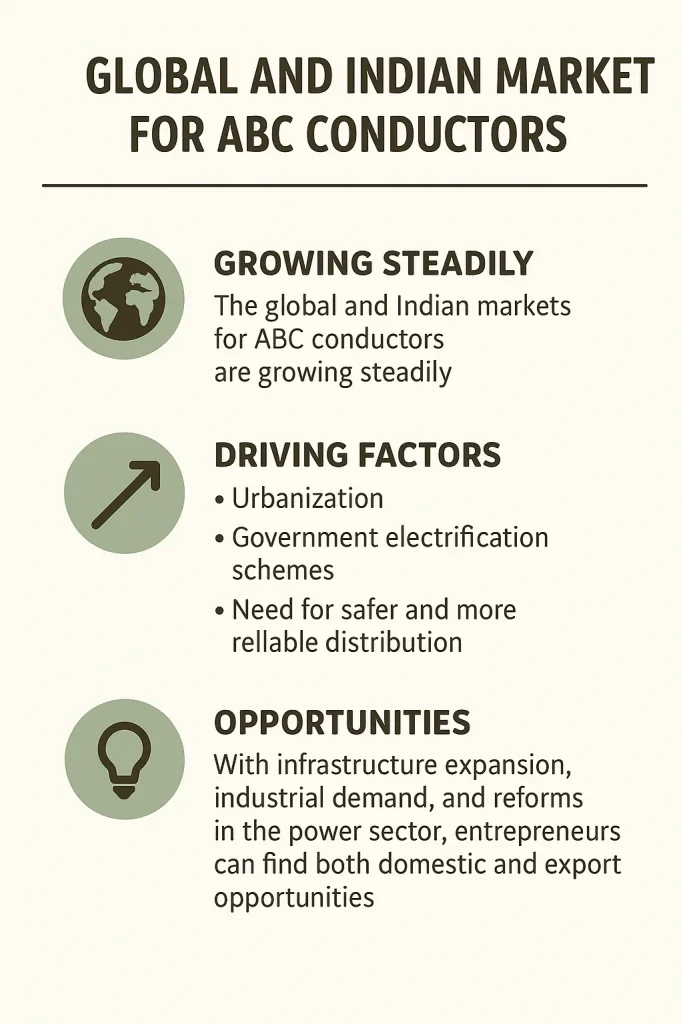Aerial Bundled Cables (ABC) are modern overhead power distribution solutions that replace traditional bare conductors. They are insulated and bundled together, which improves safety, reduces transmission losses, and increases reliability. For entrepreneurs, this sector offers strong opportunities as utilities, infrastructure developers, and rural electrification projects are increasingly adopting ABC conductors for distribution networks.
Market Outlook and Opportunity

The global and Indian markets for ABC conductors are growing steadily. This growth is driven by urbanization, government electrification schemes, and the need for safer and more reliable distribution. Utilities are moving away from bare overhead conductors due to safety risks, high technical losses, and concerns about theft. With infrastructure expansion, industrial demand, and reforms in the power sector, entrepreneurs can find both domestic and export opportunities.
Key Applications and Benefits
ABC conductors are used widely in overhead distribution lines, rural electrification, temporary connections, and in densely populated urban areas. Their insulation prevents electricity theft, improves safety for workers and the public, reduces maintenance costs, and increases efficiency compared to bare conductors. Their long service life and lower installation costs also make them appealing to utilities and contractors.
For in-depth insights, see our books.
Manufacturing Process Overview
The process starts with selecting raw materials, including aluminum conductors, XLPE (cross-linked polyethylene) or PVC insulation, and accessories. Next, stranding prepares the aluminum conductor core, followed by the extrusion of insulation over the individual conductors. After that, these insulated cores are bundled together. A messenger wire, often made from steel-reinforced aluminum or all-aluminum alloy, may be added for strength. The final steps include binding, sheathing, and quality testing before packaging.
Detailed project report on Manufacturing of ABC conductor
Quality Control and Standards
Strict quality checks ensure mechanical strength, electrical conductivity, insulation thickness, and resistance to weathering and UV damage. Testing standards usually follow IS (Indian Standards), IEC, or equivalent global benchmarks. Routine tests include tensile strength, elongation, insulation resistance, high-voltage withstand, and flame-retardant properties. Maintaining certifications builds trust with utilities and contractors.
Plant Layout, Equipment, and Operations
Key equipment includes conductor stranding machines, extruders for insulation, laying-up machines, binding units, and quality testing labs. A well-organized plant ensures a smooth flow from wire drawing and stranding to insulation and final bundling. Dust control, safe handling of polymer materials, and continuous monitoring systems are essential for efficiency.
Environmental, Safety, and Regulatory Considerations
Environmental factors include managing polymer scrap, reducing emissions from extrusion, and properly disposing of or recycling waste. Safety protocols must address high-voltage testing, handling heated extrusion lines, and protecting workers. Compliance with ISO standards, Bureau of Indian Standards (BIS), and energy-efficiency guidelines enhances credibility.
Go-to-Market and Differentiation
Entrepreneurs can stand out by providing consistently high-quality ABC conductors, offering customized conductor sizes, and delivering value-added services such as technical support and installation guidance. Building partnerships with government electrification programs, contractors, and power utilities can secure long-term demand. There are also export opportunities in developing regions with similar electrification needs.
Related articles:- Semiconductors in India: How Modi’s Engine is Fueling the Next Chip but May Be Jammed
Risks and Mitigations
Fluctuations in raw material prices, especially for aluminum and polymers, pose significant risks. Long-term supplier contracts and efficient procurement strategies can help mitigate these risks. Meeting strict utility specifications is another challenge; establishing strong quality systems can reduce rejection rates. Ensuring timely delivery and maintaining effective logistics are essential for customer retention.
Scaling and Value-Add Opportunities
Options for scaling include offering specialty cables, such as aerial bundled cables with neutral messenger wires, fire-resistant grades, and low-loss designs. Entrepreneurs can also integrate recycling facilities for conductor and insulation scrap or create turnkey supply solutions for utilities, including conductors, accessories, and installation.
Practical Startup Checklist
- Define the target market and customer segment (utilities, contractors, exports).
- Source reliable suppliers for aluminum and insulation materials.
- Establish a production line with stranding, extrusion, and bundling capabilities.
- Set up in-house testing for electrical and mechanical performance.
- Obtain certifications (BIS, IEC, ISO) to build trust with buyers.
About Niir Project Consultancy Services (NPCS)
Niir Project Consultancy Services (NPCS) prepares Market Survey and Detailed Techno-Economic Feasibility Reports. These reports include manufacturing processes, raw materials, plant layouts, and financials. NPCS helps entrepreneurs evaluate the feasibility of starting new industries and businesses by providing practical, data-backed insights.
Conclusion
Manufacturing ABC conductors offers a strong opportunity in the evolving power distribution sector. With growing demand for safe, reliable, and cost-effective electrification, businesses entering this field can achieve long-term growth by focusing on quality, compliance, and strategic partnerships with utilities and infrastructure developers.
Use our startup selector tools to discover the best business ideas for you
Frequently Asked Questions
What are ABC conductors?
Aerial Bundled Cable (ABC) conductors are overhead power distribution cables that bundle multiple insulated wires together for efficient transmission.
Why are ABC conductors in demand?
They reduce power theft, improve safety, and minimize maintenance compared to traditional bare conductors.
Where are ABC conductors widely used?
They are extensively used in urban and rural electricity distribution networks.
What is the market outlook?
As electrification projects and infrastructure development increase, demand for ABC conductors is growing significantly.
How does NPCS help in setting up this business?
NPCS offers detailed techno-economic reports covering processes, raw materials, plant layout, and financial feasibility for ABC conductor manufacturing.